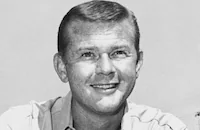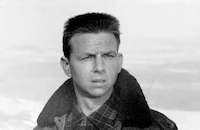Destination Gobi
Brief Synopsis
Cast & Crew
Robert Wise
Richard Widmark
Don Taylor
Casey Adams
Murvyn Vye
Darryl Hickman
Film Details
Technical Specs

Synopsis
In November 1944, Chief Bosun's Mate Sam McHale is aghast to learn that he is being transferred from his beloved aircraft carrier to a Navy-operated weather station in the Gobi Desert in Inner Mongolia. Capt. Gates explains to McHale that accurate weather forecasts are crucial to the Allies' success in the Pacific theater, and that his practical experience is required by meteorologist Commander Hobart Wyatt and his crew of scientists: Jenkins, Walter Landers, Wilbur "Coney" Cohen, Elwood Halsey, Frank Swenson and Paul Sabatello. Despite his longing for the ocean, McHale adjusts to life in the desert during the following six months, although Wyatt is bemused by McHale's dependence on the military's strict chain of command. Three weeks before they are to be relieved, the crew learns that Japanese cavalry has been spotted nearby, and McHale begins plans for increasing the outpost's negligible defenses. The group is also baffled by the arrival of a tribe of nomadic Mongols, who camp at the station's oasis. After determining that the Navy men are not interested in the oasis' grass, the Mongols' leader, Kengtu, expresses no further interest in them until Elwood attempts to take photographs of the tribe. The Mongols react hostilely, but McHale gains Kengtu's respect when he shows him how the camera works. Observing the Mongols' riding expertise, former cowboy Jenkins muses that they would make an excellent cavalry. The next day, Kengtu orders his people to return the many things they have stolen from the station, although McHale allows them to keep his own cap and Wyatt's dress uniform. Later that day, the Navy men learn that due to increasing pressure from the enemy, they will not be relieved. Hoping to persuade the Mongols to help them defend the station, McHale requisitions sixty saddles, and although the order is met with bewilderment, the saddles soon arrive and the delighted Mongols begin training with Jenkins, who dubs them the "1st Mongolian Cavalry, U.S. Navy." Before long, however, the camp is bombed by Japanese planes, and Wyatt and several Mongols are killed. The radio is also destroyed, and McHale is disappointed when the Mongols disappear, leaving them alone and defenseless. Rather than walking 300 miles to the nearest weather station, which might also have been attacked, McHale decides that the men should travel 800 miles to the sea. The men are flabbergasted, but McHale's determination to return to the ocean prevails and they begin walking. Hoping to reach Peking, and from there sail to Okinawa, which is held by American forces, McHale drives the men onward, and they stop at an oasis at which some Chinese traders are camped. Also at the oasis are Kengtu and his people, and McHale reproaches the chief for deserting them. Kengtu replies that he had to protect his people from the "birds in the sky," and when McHale demands protection in exchange for the saddles, Kengtu returns the saddles. Chinese trader Yin Tang then offers to give McHale four camels for the saddles, and the next day, the Americans travel with the Chinese. That night, however, the treacherous Yin Tang attempts to kill them, but is stopped by the arrival of Kengtu and his men. Kengtu tells McHale that his people want the saddles back and are willing to escort the Americans to Peking, provided that they dress in native garb to avoid the Japanese. McHale agrees, although the men worry that they will be considered spies if they are captured because they will be out of uniform. Kengtu's plan appears to be working, however, until they reach the Chinese village of Sangchien, which is a garrison for the Japanese. Power-hungry Mongol Tomec, fed up with the troublesome Americans, appears to persuade Kengtu to turn them in, and later, McHale is horrified when Kengtu leads them into an ambush by Japanese soldiers. The Navy men are taken to a prison camp near the ocean, and when he is questioned by a Japanese officer, McHale refuses to divulge any information about the remaining weather stations. Angered, the officer holds the men as spies rather than prisoners of war, which means they will be shot. Their depression is lifted, however, by the arrival of one of Kengtu's men, Wali-Akhun, who was arrested while wearing Wyatt's stolen uniform. Wali reveals that Kengtu has arranged for their escape, and that night, they sneak out of the camp and to the docks, where Kengtu is waiting with a Chinese junk. Kengtu explains to McHale that he did not betray them, but rather tricked the Japanese soldiers into transporting them to the ocean. An alarm sounds, and as a Japanese search party approaches, Kengtu and his men are forced to board the junk and accompany the Americans. They are pursued by a motorboat, but are able to sink it with an ancient cannon stolen by the Mongols. Coney is killed during the battle, however, and the men soberly set sail for Okinawa. Eleven days later, the junk is spotted by American planes, which are about to bomb it until they see a large sign, with the inscription U.S.S. Cohen painted on it. The men are rescued, and soon after, Kengtu is returned to his people, along with sixty saddle blankets. Kengtu and McHale say farewell, and when McHale tries to explain that he is not the head chief of the Navy, as Kengtu had mistakenly thought, Kengtu replies that it is the Navy's mistake, not his.

Director

Robert Wise
Cast

Richard Widmark

Don Taylor
Casey Adams

Murvyn Vye

Darryl Hickman

Martin Milner
Ross Bagdasarian
Judy Dann
Rodolfo Acosta
Russell Collins
Leonard Strong

Earl Holliman
Edgar Barrier
Anthony Earl Numkena

Alvy Moore
Stuart Randall
William Forrest
Bert Moorhouse
Jack Raine
Richard Allan
Frank Iwanaga
William Self
Rollin Moriyama
Edo Mita
Frank Kumagi
Harris Matsushige
Robert Kino
Beal Wong

Russ Conway
Ray Montgomery
John Hedloe
Leon Needham
James Conaty
Franklyn Farnum

Richard Loo
Rush Williams

Willis Bouchey
Gorden Frazier
Crew
Angela Alexander
Charles G. Clarke
Lewis Creber
Leonard Doss
A. F. Erickson
Everett Freeman
Robert Fritch
R. L. Hough
Anthony Jowitt
Sol Kaplan
Ray Kellogg
Arthur L. Kirbach
Charles Lemaire
Harry M. Leonard
Paul Lockwood
Harry Maret
J. Richard Maybery
Owen Mclean
Robert Metzler
Alfred Newman
Ray Nolan
Ben Nye
Al Orenbach
Edward Powell
Victor Price
Stanley Rubin
Richard Rudolph
Stanley Scheuer
David Silver
Roy Stork
Erich Von Stroheim Jr.
Frank Sullivan
Don Torpin
Wesley Trist
Thomas Tuttle
Lyle Wheeler

Film Details
Technical Specs

Articles
Robert Wise (1914-2005)
Born on September 10, 1914 in Winchester, Ind., Wise was a child of the Depression who quit college to earn a living in the movie industry. He began as an assistant cutter at RKO, where he worked his way up to the position of film editor and earned an Oscar® nomination for his bravura work with Orson Welles on Citizen Kane. He also edited The Magnificent Ambersons (1942) for Welles, along with several other RKO films.
Wise became a director by default when RKO and producer Val Lewton assigned him to The Curse of the Cat People (1944) after Gunther von Fritsch failed to meet the film's production schedule. Wise turned the film into a first-rate psychological thriller, and enjoyed equal success with another Lewton horror film, The Body Snatcher (1945).
Critical praise also was showered upon Wise's Born to Kill (1947), a crime melodrama; and Blood on the Moon (1948), an unusual psychological Western starring Robert Mitchum. Even more highly regarded was The Set-Up (1949), a no-punches-pulled boxing drama that won the Critics' Prize at the Cannes Film Festival. Wise moved on from RKO in the early 1950s, directing one of the movies' classic alien invasion films, The Day the Earth Stood Still, for 20th Century Fox.
At MGM he directed Executive Suite (1954), a compelling all-star boardroom drama; Somebody Up There Likes Me, a film bio of boxer Rocky Graziano that established Paul Newman as a major star; and The Haunting (1963), a chilling haunted-hause melodrama. His films for United Artists include Run Silent, Run Deep (1958), a submarine drama with Clark Gable and Burt Lancaster; I Want to Live! (1958), a harrowing account of a convicted murderess on Death Row, with Susan Hayward in her Oscar-winning performance; and the crime caper Odds Against Tomorrow (1959).
Wise served as president of the Academy of Motion Picture Arts and Sciences and the Directors Guild of America. He was awarded the Academy's Irving G. Thalberg Memorial Award in 1966, and the Directors Guild's highest honor, the D.W. Griffith Award, in 1988. He remained active as a director through the 1970s. His final film, Rooftops (1989) was a musical with an urban setting that recalled West Side Story.
The films in TCM's salute to Robert Wise are Citizen Kane (1941), The Magnificent Ambersons (1942), The Curse of the Cat People (1944), The Body Snatcher (1945), Born to Kill (1947), Blood on the Moon (1948), The Set-Up (1949), Executive Suite (1954), Somebody Up There Likes Me (1956), Run Silent, Run Deep (1958), B>West Side Story (1959), Odds Against Tomorrow (1959) and The Haunting (1963).
by Roger Fristoe

Robert Wise (1914-2005)
Quotes
Well, looks like you made a hit, Walter my boy. Tell me, how do you do it?- Jenkins
My training as a meterorologist. I can take one look at a girl and tell weather.- Walter Landers
Trivia
Notes
The working titles of this film were Ninety Saddles for Kengtu, Sixty Saddles for Gobi and Gobi Outpost. After the picture's opening credits, a written foreword reads: "In the Navy records in Washington, there is an obscure entry reading 'Saddles for Gobi.' This film is based on the story behind that entry-one of the strangest stories of World War II." According to studio publicity, Edmund G. Love's magazine article was based on a real incident that occurred during World War II, in which U.S. military meteorologists stationed in the Gobi Desert gave ninety saddles to a Mongolian tribe as a gesture of good will. A January 1952 Daily Variety news item announced that Love would be working on the screenplay, but the extent of his contribution to the completed screenplay, if any, has not been determined.
A January 20, 1952 Los Angeles Times article speculated that Richard Basehart, William Lundigan, David Wayne and Gary Merrill were going to be cast in the film. Hollywood Reporter news items include the following actors in the cast, although their appearance in the completed picture has not been confirmed: John Fritz, King Kong, Sunrise Riley, Dayton Lummis, Dayton Moore, Ray Montgomery, Russ Conway and Hugh Beaumont. Studio publicity notes that Willis Bouchey was originally signed to play "Capt. Briggs," but he appeared as "Capt. Gates"; Stuart Randall played Briggs. Hollywood Reporter news items and studio publicity list Nixon and Fallen, NV as location sites, and note that Piute Indians residing on a reservation in Nixon played Mongol extras. Destination Gobi was Robert Wise's first color film.

Miscellaneous Notes
Released in United States Spring March 1953
Released in United States Spring March 1953













